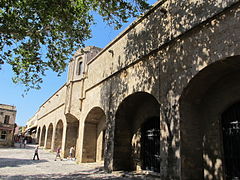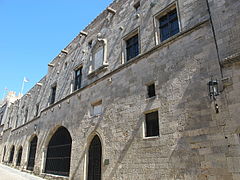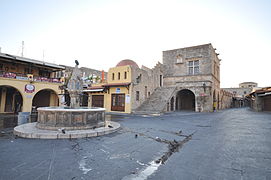Medieval city of Rhodes
| Medieval city of Rhodes | |
|---|---|
|
UNESCO world heritage |
|

|
|
| The Marientor at the harbor |
|
| National territory: |
|
| Type: | Culture |
| Criteria : | ii, iv, v |
| Reference No .: | 493 |
| UNESCO region : | Europe and North America |
| History of enrollment | |
| Enrollment: | 1988 (session 12) |
The Medieval City of Rhodes is the old town of Rhodes , which was declared a World Heritage Site by UNESCO in 1988 . The so-called Order of St. John - the "Order of the Hospital of St. John in Jerusalem" - was owned by Rhodes from 1309 to 1523 and during this time set about turning the city into a strong fortress . In the following period it came under Turkish and Italian rule. With the Grand Master's Palace, the Great Hospital and the Ritterstrasse, the upper town of this old town ("Kollachium") is one of the most beautiful urban ensembles of the late Middle Ages. In the lower town (“Chora”), late medieval architecture mixes with mosques, public baths and other buildings from the Turkish era.
The lower town of the old town is divided into the Turkish quarter and the former Jewish quarter, called La Juderia .
History and structure of the old town
Overview of the history of the city of Rhodes
- 408 BC Chr .: The city was founded on the occasion of the merger of the three Poleis Ialysos , Kameiros and Lindos as the common capital.
- The following three centuries were the "golden age" of Rhodes.
- 226 BC Chr .: An earthquake overturned the statue of the so-called Colossus of Rhodes and destroyed part of the city.
- 164 BC BC: The previously independent city came under Roman administration. In the years that followed, it was still considered the center of education, science and the arts.
- 330 to 650 AD: Rhodes was part of the Byzantine Empire . During this time, the city was the seat of a bishopric and an important military base.
- 7th century: An Arab fleet under Mauawiya captured the city in 654. It was kept occupied until 678.
- In the following years the city shrank, but was fortified with walls by the resurgent Byzantines.
- 1082: Venice established the first trading post on the island, which led to renewed reputation and an increase in prosperity.
- 1204: As a result of the Fourth Crusade , the city fell to the Franks .
- 1278: The Byzantines were able to regain control of the city and island at short notice.
- 1306: From this year the Order of St. John took possession of the island. The city of Rhodes fell after a long siege in 1309 during the reign of Grand Master Fulko of Villaret . The Order moved its headquarters to the city, expanded it into a fortress and became one of the dominant forces in the eastern Mediterranean.
- 1523: after months of siege , the Johanniter had to cede the city and the island to the Ottomans on January 1st, 1523.
Structure of the fortress
The current old town is an impressive fortress of the Order of St. John from the 14th century. It is partly on a hill and is surrounded by a four-kilometer fortress wall that extends to the harbor. This wall was divided into eight defensive sections, each of which was assigned to groups of knights with different "tongues":
- In the north the French wall with the d 'Amboise gate, the Amboise bastion, the Plaignes tower, the St. Peter tower, the freedom gate, the Paulus bastion and the Naillac tower at the harbor,
- in the west the German wall with the Georgsturm and the Georgsbastion,
- south of it the wall of the knights of Auvergne ,
- southwest the wall Krone Aragon with the Spanish bastion,
- in the south between the Marienturm with Marienbastion and the Johannesturm with Johannesbastion the English wall with the St. Athanasios tower,
- southeast the wall of the knights of Provence ,
- east to the sea the wall of the Italians with the Bastion del Carretto and the Akandia gate
- and in the north along the port facility along the walls of Castile with the mill gate, the Marientor, the marine gate, the hospital gate and the arsenal gate as well as the angel tower.
The St. George's Bastion was built between 1421 and 1431 on the western land side of the city wall to strengthen it.
The old town was divided into two unequal areas by an inner wall. In the north it separated the "Kollachium" (also called Castello ), the living and administrative area of the knights. The greater southern part of the "Chora" (also Burgum) was the trading center and settlement area of the Greeks and Western Europeans. The Jews lived in a separate quarter in the east of the old town, which was called La Juderia after the settlement of Sephardic Jews in the 16th century . In addition to the dominant medieval architecture, several buildings from the time of the Ottoman occupation between 1523 and 1912 have been preserved, but the old town contains few pagan or early Christian buildings.
Description of the old town
Upper Town
After entering the fortress city through the Liberty Gate (Eleftherias Gate), which was only opened by the Italians in 1924, one reaches Symi Square, where the foundations of a Hellenistic Temple of Aphrodite are to the east. In the center of Argyrokastro Square is a fountain consisting of a Byzantine baptismal font and a column from the 7th to 8th centuries; the Folklore Museum and the Institute for History and Archeology are also located here. The large hospital of the Knightly Order, which was built between 1440 and 1489 and now houses the Archaeological Museum, is located on Museum Square. Opposite is the Byzantine church Panagia tou Kastrou from the 11th century, which was converted into the three-aisled Catholic Church of Santa Maria del Castello from 1319 to 1334 after the arrival of the Knightly Order. Nowadays it is a dépendence of the Archaeological Museum and is used for the exhibition of church works of art.
At the restored by the Italians and with pebbles paved Knight Street (Greek Odos Ippoton ) are the "Hostels of tongues," the chivalrous Landsmannschaften of St John. Originally the Order of St. John consisted of seven "tongues": Provence, Auvergne, France, Italy, Aragon, England and Germany. In 1461 Aragon was divided and Castile became the eighth "tongue". Uphill to the west, the hostels are lined up on the right-hand side. Only the hostel of the Spaniards is on the left, roughly in the middle of Ritterstrasse. The Auvergne hostel is located on the Platia Argyrokastrou ("Argyrokastro Square"), the English on the Platia Mouseiou ("Museum Square"). The accommodation of the German contingent has not been preserved, its existence is also partly doubted.
The approximately 200-meter-long Ritterstraße ends at Kleobulos-Platz, where the 80 by 75 meter building of the Grand Master's Palace of the Order of St. John rises at the highest point in the old town . In antiquity, the lower acropolis of the city with the main temple of the sun god Helios was located on the site of the Grand Master's Palace . The actual location of the Colossus of Rhodes is assumed to be at the place in front of this sanctuary . The imperial governor's castle was at the same location in Byzantine times before construction began on the Grand Master’s Palace around 1350. After the Ottoman conquest of the island in 1522, the palace served as a prison and powder magazine under the Ottomans .
In 1856 the palace was destroyed by a huge explosion from the powder store. It was rebuilt by the Italians from 1937 to 1940 and restored again in 1988. The reconstruction should not be true to the original either. B. used antique mosaic floors from the island of Kos , since the wish of the King of Italy and later of Benito Mussolini was to have a representative residence here. In the rooms and halls of the Grand Master's Palace, two historical exhibitions about life in ancient times and in the Middle Ages are shown.
Lower town
In 1507 the "Kastellania" was built on Hippokrates Square, a building that served as the criminal court of the knights of the order. The parish church Ágios Fanoúrios probably dates back to the 9th century, the Kahal Shalom synagogue was most likely built in 1577 AD and is therefore one of the oldest synagogues in Greece. The Jewish Museum Rhodes , which recalls the long history of the former Jewish quarter and its population, is also housed in the synagogue complex .
The mixture of Gothic and Ottoman architecture, the mixture of old, uninhabited stone houses and newly built or renovated houses with the wide range of eateries, shops and cafés creates a colorful, picturesque picture in this World Heritage city. The tourist flair is especially created by the many narrow streets and small squares, which are cobblestone and can only be reached or crossed on foot - or by the local residents by motorcycle. In the main summer season there is a fearful crowd in this old town, as the tourists of the nearby large hotels and resorts are joined by the passengers of the large cruise ships.
World Heritage
The following criteria were decisive for the World Heritage award:
Criterion (ii): "The fortifications of Rhodes, a" Frankish "town long considered to be impregnable, exerted an influence throughout the eastern Mediterranean basin at the end of the Middle Ages."
(The fortifications of Rhodes, long considered an impregnable Franconian city, exercised considerable influence throughout the eastern Mediterranean until the end of the Middle Ages.)
Criterion (iv): "This cultural property is an outstanding example of an architectural ensemble which illustrates the significant period of history in which a military / hospital order founded during the Crusades survived in the eastern Mediterranean area in a context characterized by an obsessive fear of win. Rhodes is one of the most beautiful urban ensembles of the Gothic period. The fact that this medieval city is located on an island in the Aegean Sea, that it was on the site of an ancient Greek city, and that it commands a port formerly embellished by the Colossus erected by Chares of Lindos, one of the Seven Wonders of the ancient world, only adds to its interest. Finally, it must be noted that the chain of history was not broken in 1523 but rather continued up to 1912 with the additions of valuable Islamic monuments, such as mosques, baths and houses. "
(This cultural monument is an excellent example of an architectural ensemble that illustrates the significant historical epoch in which a militant hospital order, founded during the Crusades, continued to exist in the eastern Mediterranean in the obsessive fear of sieges. Rhodes is one of the most beautiful urban ensembles of the late Middle Ages, the fact that this medieval city is located on an island in the Aegean Sea, that it is on the site of an ancient Greek city and that it dominates a port formerly built by the colossus built by Chares of Lindos was embellished - one of the seven wonders of antiquity - only adds to the significance. Finally, it must be noted that the historical tradition was not broken in 1523, but rather continued until 1912: valuable Islamic monuments were added, such as Mosques, baths and houses.)
Criterion (v): “With its Frankish and Ottoman buildings the old town of Rhodes is an important ensemble of traditional human settlement, characterized by successive and complex phenomena of acculturation. Contact with the traditions of the Dodecanese changed the forms of Gothic architecture and building after 1523 combined vernacular forms resulting from the meeting of two worlds with decorative elements of Ottoman origin. All the built-up elements dating before 1912 have become vulnerable because of the evolution in living conditions and they must be protected as much as the great religious, civil and military monuments, the churches, monasteries, mosques, baths, palaces, forts, gates and ramparts. "
(With its Franconian-Occidental and Turkish buildings, the old town of Rhodes is the important ensemble of a long-term human settlement, which is characterized by complex and successive phenomena of cultural adaptation. Contact with the traditions of the Dodecanese changed the forms of medieval architecture. And that Building after 1523 combined indigenous forms that arose from the meeting of the two worlds with decorative forms of Turkish origin.All built elements that were made before 1912 have become vulnerable due to the development of living and environmental conditions and must be protected, exactly as much as the important religious, urban and military monuments such as the churches, monasteries, mosques, baths, palaces, fortifications, gates and ramparts.)
literature
- Treasures of the World - Heritage of Mankind Vol. 3, Chronik Verlag, 2000
Web links
Individual evidence
- ↑ Description of the Medieval City of Rhodes on the World Heritage website , accessed on June 15, 2018.
- ^ Roman Period. (No longer available online.) City of Rhodes, archived from the original on April 21, 2016 ; Retrieved May 5, 2016 . Info: The archive link was inserted automatically and has not yet been checked. Please check the original and archive link according to the instructions and then remove this notice.
- ↑ Rhodes, Marco Polo, ISBN 978-3-8297-0532-5
- ↑ Description of the Medieval City of Rhodes, criteria for selection as World Heritage, accessed and translated on June 15, 2018
Coordinates: 36 ° 26 ′ 37.3 ″ N , 28 ° 13 ′ 39.2 ″ E



















